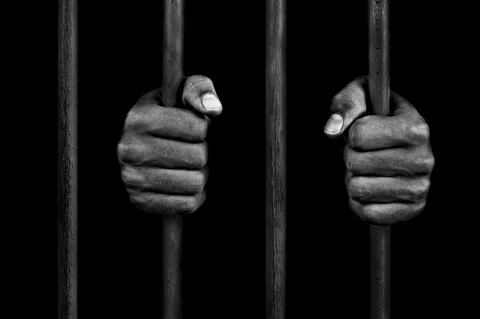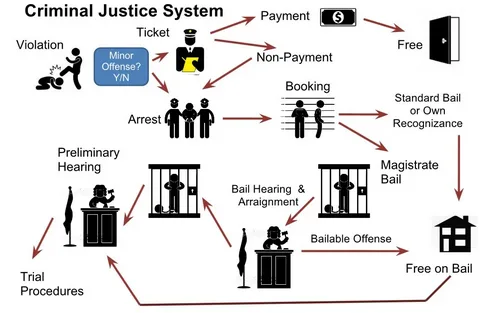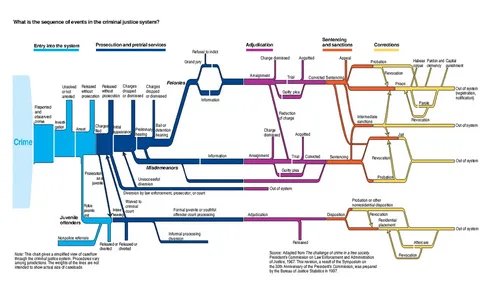
The administration of justice is a fundamental aspect of society, ensuring the maintenance of order and the protection of individual rights. Across the globe, various criminal justice systems have evolved, each with its own unique characteristics, philosophies, and methods of adjudication. Understanding the different types of criminal justice systems is essential for comprehending the diverse approaches to law enforcement, adjudication, and rehabilitation employed in different countries. From adversarial systems, where prosecution and defense engage in a legal battle, to inquisitorial systems, where judges play a more investigative role, and even restorative justice systems that prioritize reconciliation over punitive measures, the range of approaches reflects cultural, historical, and legal traditions.
Exploring these systems provides insight into the complexities of justice administration and invites critical examination of their effectiveness, fairness, and adaptability in addressing the challenges of contemporary society. In this discussion, we delve into the four primary types of criminal justice systems found around the world, highlighting their key features and implications for the pursuit of justice.
Table of Contents
Exploring the Diversity of Criminal Justice Systems Around the World
Introduction:
The administration of justice is a cornerstone of civilized society, ensuring order, safety, and the protection of individual rights. However, the methods by which justice is pursued and delivered vary significantly across different countries and legal systems. From the adversarial traditions of common law countries to the investigative approaches of civil law systems, and the innovative restorative justice practices emerging in various societies, understanding the nuances of these systems is crucial for comprehending global perspectives on law enforcement and adjudication.
Adversarial System:
The adversarial system, predominantly found in common law countries such as the United States, Canada, and England, operates on the principle of conflict between opposing parties: the prosecution and the defense. In this system, the burden of proof lies with the prosecution, which must demonstrate the guilt of the accused beyond a reasonable doubt. The adversarial nature of the proceedings means that each side is responsible for presenting evidence, examining witnesses, and challenging the arguments of the opposing party. This confrontational approach is believed to promote fairness and ensure that the truth emerges through rigorous testing of evidence and arguments in front of an impartial judge or jury.
However, critics of the adversarial system argue that its emphasis on legal maneuvering and winning cases can sometimes overshadow the pursuit of justice. The focus on procedural rules and tactics may lead to injustices, particularly for individuals who lack resources or legal representation. Moreover, the adversarial nature of the system can exacerbate the trauma experienced by victims and witnesses, who may feel like pawns in a legal game rather than participants in a quest for truth and accountability.
Inquisitorial System:
In contrast to the adversarial system, the inquisitorial system, predominant in civil law countries such as France, Germany, and Japan, places greater emphasis on the role of the judge in investigating and determining the outcome of cases. In this system, the judge takes an active role in gathering evidence, questioning witnesses, and directing the proceedings. The goal is not merely to adjudicate disputes between opposing parties but also to uncover the truth and ensure a just resolution to the case.

Proponents of the inquisitorial system argue that its investigative approach reduces the adversarial tension inherent in the adversarial system and promotes efficiency and accuracy in decision-making. By placing the responsibility for fact-finding squarely on the shoulders of the judiciary, the inquisitorial system minimizes the risk of procedural gamesmanship and ensures that cases are decided based on the merits of the evidence rather than the skill of legal advocates.
However, critics of the inquisitorial system raise concerns about the concentration of power in the hands of judges and the potential for abuse or bias in their decision-making. The lack of robust adversarial testing may also limit opportunities for defendants to challenge evidence or present alternative narratives, potentially compromising the fairness of the process. Additionally, the inquisitorial system’s reliance on written records and formal procedures may hinder the ability of participants to fully engage with the proceedings and contribute to the search for truth.
Mixed System:
In some jurisdictions, such as Italy and Spain, elements of both the adversarial and inquisitorial systems are combined to form a hybrid or mixed system. In these systems, judges play an active role in managing cases and ensuring procedural fairness, but they also allow for a degree of adversarial confrontation between opposing parties. The exact balance between adversarial and inquisitorial elements varies depending on the legal traditions and practices of each country.
The mixed system seeks to combine the strengths of both adversarial and inquisitorial approaches while mitigating their respective weaknesses. By incorporating elements of adversarial testing and cross-examination, the mixed system aims to promote robust debate and the presentation of competing perspectives while still ensuring the active involvement of judges in guiding the proceedings and uncovering the truth.
Restorative Justice System:
In recent years, there has been growing interest in restorative justice as an alternative approach to traditional adversarial or inquisitorial systems. Restorative justice focuses on repairing the harm caused by crime and addressing the needs of both victims and offenders through dialogue, mediation, and reconciliation. Rather than emphasizing punishment or legal guilt, restorative justice seeks to foster healing, accountability, and community involvement in the resolution of conflicts.
In restorative justice processes, victims have the opportunity to express the impact of the offense on their lives and participate in determining appropriate responses or restitution. Offenders are encouraged to take responsibility for their actions, acknowledge the harm they have caused, and make amends to those affected by their behavior. Community members may also play a role in supporting the healing process and reintegrating offenders into society.
Proponents of restorative justice argue that it offers a more humane and effective approach to addressing crime by focusing on the needs of individuals and communities rather than the demands of the legal system. By promoting dialogue and reconciliation, restorative justice can help repair relationships, prevent future harm, and reduce recidivism rates. Additionally, restorative justice processes may be particularly beneficial in cases involving nonviolent offenses, juvenile offenders, or community-based conflicts where traditional punitive measures may be less effective or appropriate.
Conclusion:
The diversity of criminal justice systems around the world reflects the complex interplay of cultural, historical, and legal factors shaping each society’s approach to law enforcement and adjudication. While the adversarial system emphasizes legal rights and procedural fairness, the inquisitorial system prioritizes truth-seeking and judicial oversight. Mixed systems seek to combine the strengths of both approaches, while restorative justice offers an alternative paradigm focused on healing and reconciliation.
As societies grapple with evolving challenges and aspirations for justice, understanding the strengths and limitations of different criminal justice systems becomes increasingly important. By critically examining the principles, practices, and outcomes of these systems, we can identify opportunities for reform, innovation, and the pursuit of justice that is fair, effective, and responsive to the needs of individuals and communities alike.
The exploration of criminal justice systems around the world reveals a tapestry of diverse approaches shaped by historical, cultural, and legal traditions. From the adversarial battlegrounds of common law courts to the investigative inquiries of civil law tribunals, and the transformative dialogues of restorative justice circles, each system reflects unique philosophies and priorities in the pursuit of justice.
The adversarial system, with its emphasis on procedural fairness and adversarial testing, stands as a bastion of legal rights and due process in common law jurisdictions. However, its reliance on legal maneuvering and the adversarial contest may sometimes obscure the quest for truth and compromise the pursuit of justice.
In contrast, the inquisitorial system, predominant in civil law countries, places the pursuit of truth at the forefront, empowering judges to actively investigate cases and direct proceedings. Yet, concerns about judicial discretion and the potential for abuse underscore the delicate balance between investigative rigor and procedural safeguards.
Mixed systems, such as those found in Italy and Spain, attempt to reconcile the strengths of adversarial and inquisitorial approaches, offering a nuanced blend of procedural fairness and judicial oversight. However, the challenge lies in striking the right balance between adversarial confrontation and judicial intervention to ensure both fairness and efficiency.
Amidst these established systems, the emergence of restorative justice as an alternative paradigm offers a beacon of hope for transformative justice. By prioritizing healing, accountability, and community involvement, restorative justice seeks to repair the harm caused by crime and address the underlying causes of conflict. However, its implementation alongside traditional criminal justice systems presents challenges of scalability, procedural consistency, and legal accountability.
As societies grapple with evolving challenges and aspirations for justice, the critical examination of criminal justice systems becomes increasingly vital. The pursuit of justice transcends mere adherence to legal procedures; it demands a commitment to fairness, accountability, and the recognition of the human dignity of all individuals affected by the legal process.
In this journey towards a more just and equitable society, understanding the nuances of criminal justice systems worldwide serves as a compass guiding us towards reforms, innovations, and transformative approaches. By fostering dialogue, collaboration, and cross-cultural exchange, we can strive to create legal systems that uphold the principles of fairness, integrity, and respect for human rights for generations to come.
Ultimately, the pursuit of justice is not merely a legal endeavor but a moral imperative—one that calls upon individuals, communities, and institutions to uphold the inherent dignity and worth of every human being, and to work together towards a world where justice is not just a lofty ideal but a lived reality for all.

Frequently asked questions (FAQs) regarding criminal justice systems around the world:
- What are the main differences between adversarial and inquisitorial systems?
- Adversarial systems, common in common law countries, involve two opposing parties (prosecution and defense) presenting their cases before an impartial judge or jury. In contrast, inquisitorial systems, predominant in civil law countries, involve judges taking an active role in investigating cases, questioning witnesses, and determining guilt or innocence.
- How do mixed systems combine elements of adversarial and inquisitorial systems?
- Mixed systems, found in countries like Italy and Spain, incorporate both adversarial and inquisitorial elements. Judges play an active role in managing cases and ensuring procedural fairness, while still allowing for adversarial confrontation between opposing parties to some extent.
- What is restorative justice, and how does it differ from traditional criminal justice systems?
- Restorative justice focuses on repairing the harm caused by crime and addressing the needs of both victims and offenders through dialogue, mediation, and reconciliation. Unlike traditional punitive justice systems, restorative justice emphasizes healing, accountability, and community involvement in resolving conflicts.
- Which countries use adversarial, inquisitorial, or mixed systems?
- Adversarial systems are prevalent in common law countries such as the United States, Canada, and England. Inquisitorial systems are found in civil law countries like France, Germany, and Japan. Mixed systems are employed in countries such as Italy and Spain, while restorative justice practices are implemented in various jurisdictions worldwide, often alongside traditional criminal justice systems.
- What are the advantages and disadvantages of each type of criminal justice system?
- Adversarial systems promote adversarial testing and procedural fairness but may prioritize winning over the pursuit of truth. Inquisitorial systems focus on fact-finding and judicial oversight but may concentrate too much power in judges’ hands. Mixed systems aim to combine the strengths of both approaches but may face challenges in finding the right balance. Restorative justice emphasizes healing and reconciliation but may not be suitable for all types of offenses or legal contexts.
- How do criminal justice systems impact individuals’ rights and the pursuit of justice?
- Criminal justice systems shape individuals’ rights and experiences within the legal process. Systems that prioritize procedural fairness and adversarial testing may safeguard defendants’ rights but could also result in prolonged legal battles. Systems that focus on truth-seeking and judicial oversight may ensure accurate outcomes but could lead to less emphasis on individual rights. Restorative justice approaches prioritize victims’ needs and community healing but may raise questions about due process and legal accountability.
- What are some emerging trends or innovations in criminal justice systems globally?
- Emerging trends in criminal justice include the use of technology for evidence gathering and case management, alternative dispute resolution mechanisms like mediation and arbitration, and efforts to address systemic biases and disparities in the legal system. Additionally, there is growing interest in restorative justice practices as alternatives to traditional punitive approaches.
- How do cultural and historical factors influence the design and operation of criminal justice systems?
- Cultural and historical factors play a significant role in shaping criminal justice systems, influencing legal traditions, attitudes towards crime and punishment, and the role of the state in administering justice. Different societies may prioritize values such as individual rights, community welfare, or retribution, leading to diverse approaches to law enforcement and adjudication.
- Are there international standards or conventions that govern criminal justice practices globally?
- Yes, there are international standards and conventions that provide guidance on criminal justice practices, such as the Universal Declaration of Human Rights, the International Covenant on Civil and Political Rights, and the United Nations Rules for the Treatment of Prisoners. Additionally, regional bodies like the European Court of Human Rights and the Inter-American Court of Human Rights oversee compliance with human rights norms in criminal justice systems within their jurisdictions.
- How can individuals advocate for reforms or improvements in criminal justice systems?
- Individuals can advocate for reforms in criminal justice systems by raising awareness about issues such as racial disparities, wrongful convictions, or the need for restorative justice approaches. They can engage with policymakers, support organizations working for criminal justice reform, and participate in community initiatives aimed at promoting fairness, accountability, and rehabilitation within the legal system.
 Nextezone: Igniting Tomorrow's Potential with Innovation Today Innovate. Explore. Elevate. Nextezone – Where Vision Meets Innovation.
Nextezone: Igniting Tomorrow's Potential with Innovation Today Innovate. Explore. Elevate. Nextezone – Where Vision Meets Innovation.
